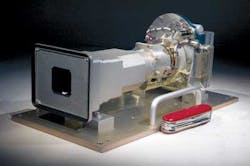Curiosity rover's cameras capture color images of Mars
When NASA's Mars Science Laboratory (MSL) rover Curiosity landed on Mars in August, four cameras developed by Malin Space Science Systems (www.msss.com) were ready to capture high-definition color images of its surface.
The first of those cameras, the Mars Descent Imager (MARDI), was active during the rover's descent, capturing hundreds of color images of the planet's surface. After the rover had landed, the second camera -- the Mars Hand Lens Imager (MAHLI) -- attached to Curiosity's robotic arm captured closeup color images of rocks on the surface of the planet.
Two cameras mounted on the mast of the rover captured color images of the terrain explored by the rover. The so-called Mastcam system's two cameras use lenses of 34-mm and 100-mm focal lengths, allowing images to be captured of objects both near to and far from the rover.
Captured images included part of the wall of Gale Crater, the location on Mars where the rover landed, which is part of a larger, high-resolution color mosaic made from images obtained by the 34-mm Mastcam over about an hour on Aug. 8, 2012.
All four Malin Space Science Systems' cameras on the Curiosity use the KAI-2020 1600 × 1200-pixel interline transfer CCD from Truesense Imaging. Today, image sensors from Truesense Imaging are used in three different orbiters around Mars and orbiters around both Venus and the Moon. In addition, a KAI-2020 image sensor is currently en route to Jupiter as part of the Juno mission and will provide color images of the planet from orbit when it arrives in 2016.
